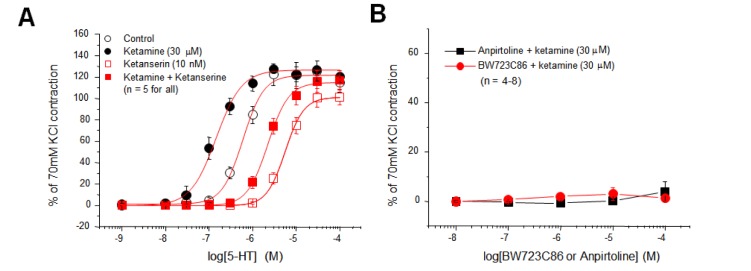Korean J Physiol Pharmacol.
2016 Nov;20(6):605-611. 10.4196/kjpp.2016.20.6.605.
Facilitation of serotonin-induced contraction of rat mesenteric artery by ketamine
- Affiliations
-
- 1Department of Emergency Medical Services, Eulji University, Seongnam 13135, Korea.
- 2Department of Physiology, KU Open Innovation Center, Research Institute of Medical Science, Konkuk University School of Medicine, Chungju 27478, Korea. ymbae30@kku.ac.kr
- 3Department of Anesthesiology, Konkuk University School of Medicine, Seoul 05030, Korea.
- 4Department of Neurology, Kangwon National University School of Medicine, Chuncheon 24289, Korea. marinen@kangwon.ac.kr
- KMID: 2364264
- DOI: http://doi.org/10.4196/kjpp.2016.20.6.605
Abstract
- Ketamine is an anesthetic with hypertensive effects, which make it useful for patients at risk of shock. However, previous ex vivo studies reported vasodilatory actions of ketamine in isolated arteries. In this study, we reexamined the effects of ketamine on arterial tones in the presence and absence of physiological concentrations of 5-hydroxytryptamine (5-HT) and norepinephrine (NE) by measuring the isometric tension of endothelium-denuded rat mesenteric arterial rings. Ketamine little affected the resting tone of control mesenteric arterial rings, but, in the presence of 5-HT (100~200 nM), ketamine (10~100 µM) markedly contracted the arterial rings. Ketamine did not contract arterial rings in the presence of NE (10 nM), indicating that the vasoconstrictive action of ketamine is 5-HT-dependent. The concentration-response curves (CRCs) of 5-HT were clearly shifted to the left in the presence of ketamine (30 µM), whereas the CRCs of NE were little affected by ketamine. The left shift of the 5-HT CRCs caused by ketamine was reversed with ketanserin, a competitive 5-HT(2A) receptor inhibitor, indicating that ketamine facilitated the activation of 5-HT(2A) receptors. Anpirtoline and BW723C86, selective agonists of 5-HT(1B) and 5-HT(2B) receptors, respectively, did not contract arterial rings in the absence or presence of ketamine. These results indicate that ketamine specifically enhances 5-HT(2A) receptor-mediated vasoconstriction and that it is vasoconstrictive in a clinical setting. The facilitative action of ketamine on 5-HT(2A) receptors should be considered in ketamine-induced hypertension as well as in the pathogenesis of diseases such as schizophrenia, wherein experimental animal models are frequently generated using ketamine.
MeSH Terms
Figure
Reference
-
1. Goodman LS, Hardman JG, Limbird LE, Gilman AG. Goodman and Gilman's the pharmacological basis of therapeutics. 10th ed. New York: McGraw-Hill;2001. p. 342–347.2. Katzung BG. Basic & clinical pharmacology. A Concise medical library for practitioner and student. 5th ed. Los Altos, Calif: Lange Medical Publications;1982. p. 350–362.3. White PF, Way WL, Trevor AJ. Ketamine--its pharmacology and therapeutic uses. Anesthesiology. 1982; 56:119–136. PMID: 6892475.
Article4. Zielmann S, Kazmaier S, Schnüll S, Weyland A. S-(+)-Ketamine and circulation. Anaesthesist. 1997; 46(Suppl 1):S43–S46. PMID: 9163278.5. Zhang G, Cui J, Chen Y, Ma J. The relaxant effect of propofol on isolated rat intrapulmonary arteries. Korean J Physiol Pharmacol. 2014; 18:377–381. PMID: 25352756.
Article7. Akata T, Izumi K, Nakashima M. Mechanisms of direct inhibitory action of ketamine on vascular smooth muscle in mesenteric resistance arteries. Anesthesiology. 2001; 95:452–462. PMID: 11506120.
Article8. Fukuda S, Murakawa T, Takeshita H, Toda N. Direct effects of ketamine on isolated canine cerebral and mesenteric arteries. Anesth Analg. 1983; 62:553–558. PMID: 6846876.
Article9. Hara Y, Chugun A, Nakaya H, Kondo H. Tonic block of the sodium and calcium currents by ketamine in isolated guinea pig ventricular myocytes. J Vet Med Sci. 1998; 60:479–483. PMID: 9592721.
Article10. Kanmura Y, Yoshitake J, Casteels R. Ketamine-induced relaxation in intact and skinned smooth muscles of the rabbit ear artery. Br J Pharmacol. 1989; 97:591–597. PMID: 2758233.
Article11. Yamazaki M, Ito Y, Kuze S, Shibuya N, Momose Y. Effects of ketamine on voltage-dependent Ca2+ currents in single smooth muscle cells from rabbit portal vein. Pharmacology. 1992; 45:162–169. PMID: 1332085.
Article12. Kapur S, Seeman P. NMDA receptor antagonists ketamine and PCP have direct effects on the dopamine D(2) and serotonin 5-HT(2) receptors-implications for models of schizophrenia. Mol Psychiatry. 2002; 7:837–844. PMID: 12232776.
Article13. Kim HS, Park IS, Park WK. NMDA receptor antagonists enhance 5-HT2 receptor-mediated behavior, head-twitch response, in mice. Life Sci. 1998; 63:2305–2311. PMID: 9877220.
Article14. Winter JC, Doat M, Rabin RA. Potentiation of DOM-induced stimulus control by non-competitive NMDA antagonists: a link between the glutamatergic and serotonergic hypotheses of schizophrenia. Life Sci. 2000; 68:337–344. PMID: 11191649.15. Watts SW. 5-HT in systemic hypertension: foe, friend or fantasy? Clin Sci (Lond). 2005; 108:399–412. PMID: 15831089.
Article16. Noh HJ, Bae YM, Park SH, Kim JG, Kim B, Kim YS, Kim SH, Cho SI, Woo NS. The vasodilatory effect of ketamine is independent of the N-methyl-D-aspartate receptor: lack of functional N-methyl-Daspartate receptors in rat mesenteric artery smooth muscle. Eur J Anaesthesiol. 2009; 26:676–682. PMID: 19352184.
Article17. Kim YH, Ahn DS, Joeng JH, Chung S. Suppression of peripheral sympathetic activity underlies protease-activated receptor 2-mediated hypotension. Korean J Physiol Pharmacol. 2014; 18:489–495. PMID: 25598663.
Article18. Banes AK, Watts SW. Upregulation of arterial serotonin 1B and 2B receptors in deoxycorticosterone acetate-salt hypertension. Hypertension. 2002; 39:394–398. PMID: 11882579.
Article19. Sung DJ, Noh HJ, Kim JG, Park SW, Kim B, Cho H, Bae YM. Serotonin contracts the rat mesenteric artery by inhibiting 4-aminopyridine-sensitive Kv channels via the 5-HT2A receptor and Src tyrosine kinase. Exp Mol Med. 2013; 45:e67. PMID: 24336234.
Article20. Domino EF, Zsigmond EK, Domino LE, Domino KE, Kothary SP, Domino SE. Plasma levels of ketamine and two of its metabolites in surgical patients using a gas chromatographic mass fragmentographic assay. Anesth Analg. 1982; 61:87–92. PMID: 7198883.
Article21. Lu R, Alioua A, Kumar Y, Kundu P, Eghbali M, Weisstaub NV, Gingrich JA, Stefani E, Toro L. c-Src tyrosine kinase, a critical component for 5-HT2A receptor-mediated contraction in rat aorta. J Physiol. 2008; 586:3855–3869. PMID: 18599541.22. Smith JR, Kim C, Kim H, Purdy RE. Precontraction with elevated concentrations of extracellular potassium enables both 5-HT1B and 5-HT2A "silent" receptors in rabbit ear artery. J Pharmacol Exp Ther. 1999; 289:354–360. PMID: 10087024.23. Kim SH, Bae YM, Sung DJ, Park SW, Woo NS, Kim B, Cho SI. Ketamine blocks voltage-gated K+ channels and causes membrane depolarization in rat mesenteric artery myocytes. Pflugers Arch. 2007; 454:891–902. PMID: 17342532.24. Bae YM, Kim A, Kim J, Park SW, Kim TK, Lee YR, Kim B, Cho SI. Serotonin depolarizes the membrane potential in rat mesenteric artery myocytes by decreasing voltage-gated K+ currents. Biochem Biophys Res Commun. 2006; 347:468–476. PMID: 16828462.25. Cogolludo A, Moreno L, Lodi F, Frazziano G, Cobeño L, Tamargo J, Perez-Vizcaino F. Serotonin inhibits voltage-gated K+ currents in pulmonary artery smooth muscle cells: role of 5-HT2A receptors, caveolin-1, and KV1.5 channel internalization. Circ Res. 2006; 98:931–938. PMID: 16527989.26. Arévalo-León LE, Gallardo-Ortíz IA, Urquiza-Marín H, Villalobos-Molina R. Evidence for the role of alpha1D- and alpha1A-adrenoceptors in contraction of the rat mesenteric artery. Vascul Pharmacol. 2003; 40:91–96. PMID: 12646397.27. Hussain MB, Marshall I. Alpha(1)-adrenoceptor subtypes mediating contractions of the rat mesenteric artery. Eur J Pharmacol. 2000; 395:69–76. PMID: 10781676.28. Yousif M, Kadavil EA, Oriowo MA. Heterogeneity of alpha 1-adrenoceptor subtypes mediating noradrenaline-induced contractions of the rat superior mesenteric artery. Pharmacology. 1998; 56:196–206. PMID: 9566021.
- Full Text Links
- Actions
-
Cited
- CITED
-
- Close
- Share
- Similar articles
-
- The Effects of Ketamine on Rat Myometrial Contractility
- Effect of Ketamine on Phenylephrine-Induced Contraction in Isolated Rat Thoracic Aorta
- The Studies on the Contractile Response of Serotinin in Rat Aorta
- Effect of pH Change on Vascular Smooth Muscle Contractility in Rat Superior Mesenteric Artery and Its Branches
- Ketamine as a Rapid-Acting Antidepressant




